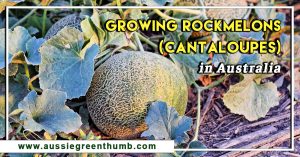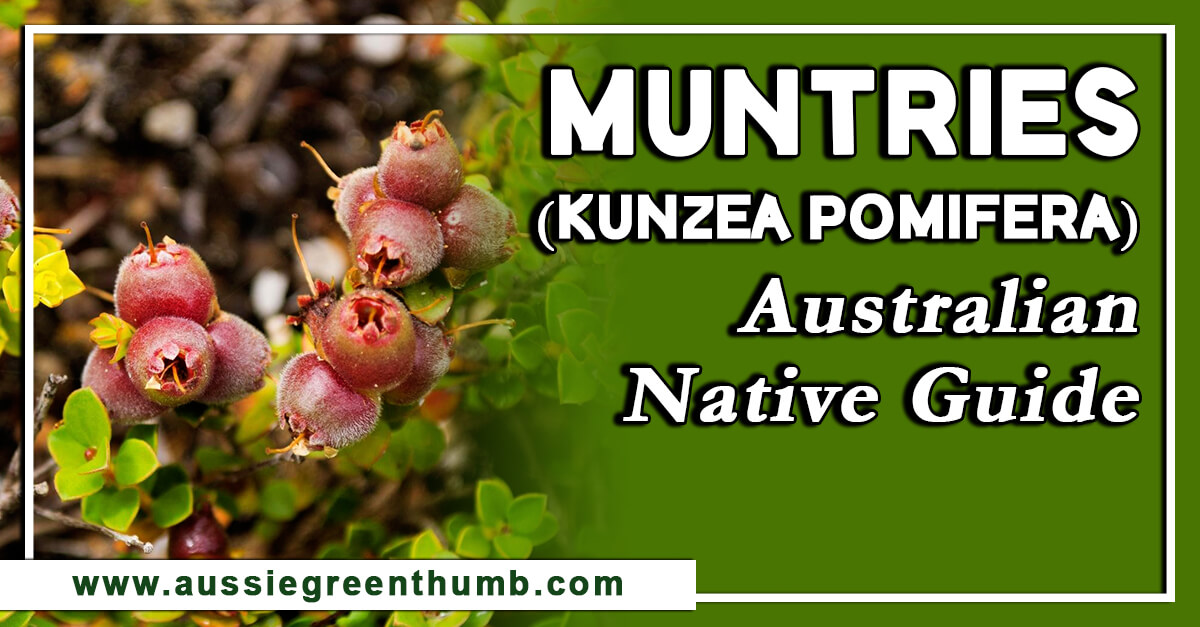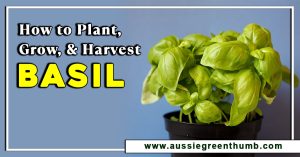Our ultimate guide to growing dianthus is based on some serious trial and error, so we’re confident that this guide isn’t just another hashed report based on plant labels, and will give you true and honest advice for how to grow dianthus.
Dianthus, or carnations, are a readily available and cheap plant, sold in gardener centres up and down the country, so you’d be forgiven for mistaking them for a cheap annual bedding plant.
The first time we grew them we just bunged them straight into a window box and hoped for the best, but the clever little dianthus plant told us exactly how wrong we were!
More...
What is a Dianthus?
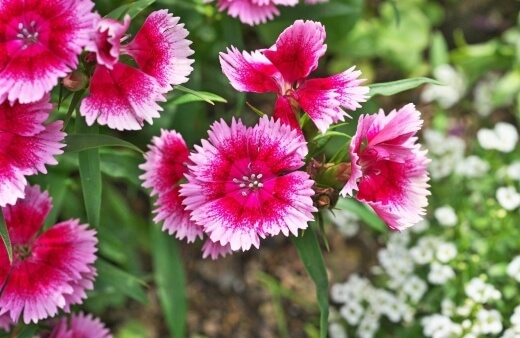
Dianthus, also known as pinks, and carnations, are Mediterranean plants, native to Greece, Croatia, Albania, Italy, Sicily and Spain. Quite how their native spread is so wide is unknown, but they are easy self-seeders and were most likely spread around Europe by migrating birds.
Carnations thrive in well-drained soil, and while they benefit from feeding once a month during the growing season, are really quite happy in poor soil, and even heavy grit mixes, as long as there is some moisture retentive compost somewhere in the mix.
Dianthus come in a massive range of sizes and some cultivars are up to 60cm tall at the height of the season, sending towering flower spikes up above other Mediterranean alpines that grow alongside them in the borders.
Dianthus flowers have a distinct almost vanilla sweetness to them and have traditionally been used as lapel flowers for that exact reason (and Sean Connery did them a few favours in his many years as James Bond).
5 Best Dianthus Species to Grow in Australia
5 Best Dianthus Varieties to Grow in Australia
1. Carthusian pink | 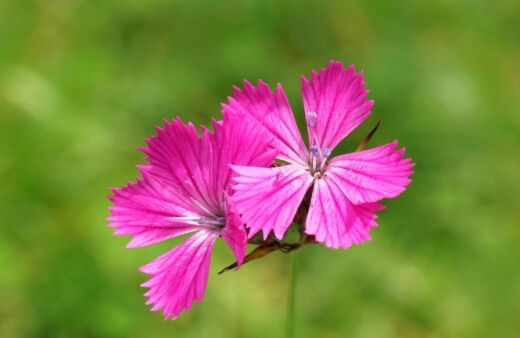 |
2. Sweet William | 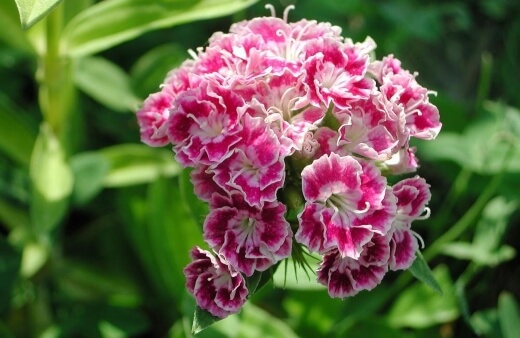 |
3. Carnation | 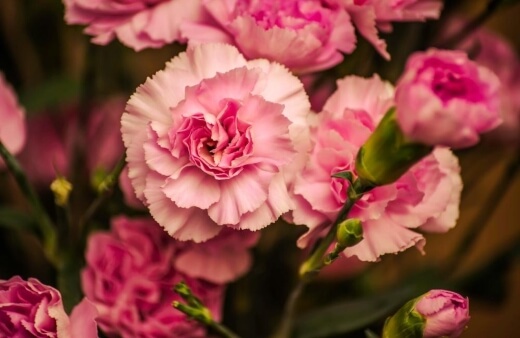 |
4. Garden Pink | 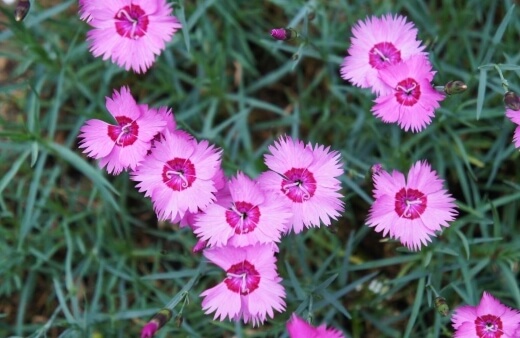 |
5. Fringed Pink | 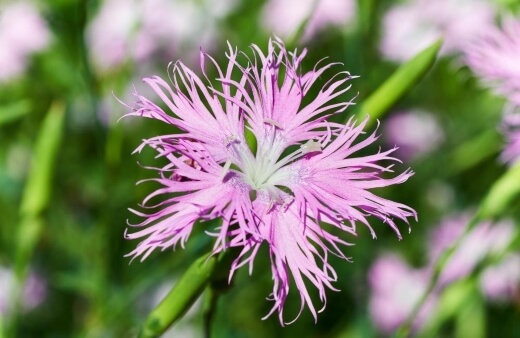 |
1. Carthusian pink (Dianthus carthusianorum)

These towering dianthus come in slightly varied shades of pink and white, so go with almost any colour scheme, and their tight bushy matt of spiked leaves across the ground is a really useful weed suppressant too.
On warm summer days, they fill the garden with an incredible aroma that is truly mesmerising.
2. Sweet William (Dianthus barbatus)

Dianthus barbatus is a good choice for anyone with slightly damper soil, as it's happy to grow in most conditions, but still prefers good drainage.
If you’re planting sweet williams in the garden, make sure to mix a little bit of grit or sand into the soil to help drainage, but otherwise, just treat them like any other Mediterranean hybrids - water in drought, and don’t mulch.
3. Carnation (Dianthus caryophyllus)

The classic carnation, Dianthus caryophyllus, comes in red, pink and white, and it's pretty hard to find subtle colours in this strain of dianthus so you’re almost certain to get some amazing cut flowers with a truly identifiable scent to fill the room.
Dianthus caryophyllus need good drainage so if you don’t have loose soil in the garden, I’d suggest treating these as container plants so you fully control their conditions. We love this variety so much, we made a full carnation how to grow and care guide to share to our readers.
4. Garden Pink (Dianthus plumarius)

Dianthus plumarius, with their striking blood-red petals, accompanied by a cluster of white fringes make them look almost like a miniature peony, but the leaves say otherwise.


Get Your Free Guide:
Master Growing Australian Natives eBook
A Must Have Complete Guide for Every Australian Garden
Get Your Free Guide:
Master Growing Australian Natives eBook
A Must Have Complete Guide for Every Australian Garden
While Dianthus plumarius is a compact little plant, it packs a serious punch.
5. Fringed Pink (Dianthus superbus)

Pronounced ‘superb-uss’, rather than ‘super-bus’, this species is a pretty magnificent flower to add to a garden when you want guests to stop and stare.
In addition to its many health benefits, the delicate fringed pinks and purples of Dianthus superbus are a thing of true beauty, with a really powerful scent, and great for trying to make up a stress-busting tea.
How to Grow Dianthus
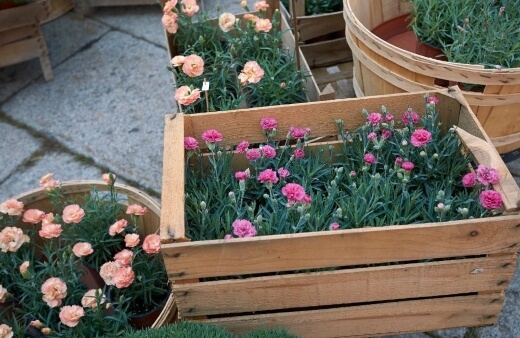
Dianthus need good drainage and full sun. They are very susceptible to root rot and hate sitting in heavy clay soils, but you can easily improve the soil with horticultural grit as they don’t need any particular nutrients to thrive.
They are most often sold as perennial bedding plants but make excellent additions to rockeries and alpine beds.
In our garden, we have a few different cultivars, including Sweet William (the classic bedding dianthus), Dianthus plumarius (with its gorgeous purple hues), but it’s Dianthus carthusianorum that really takes the prize in our borders, reliably towering over the other edging plants at 60cm tall.
We’ll cover individual aspects of dianthus care and maintenance later, but as a very basic guide, they need well-drained soil, full sun, and a big drink every few weeks in dry spells. Once you know those basic rules, you know how to grow dianthus.
How to Propagate Dianthus Flowers
Dianthus are incredibly easy to propagate from seed, cuttings or division - although dianthus cuttings and dianthus division are basically the same processes.
For gardeners looking to understand alpine plants, and gain experience, dianthus are very representative of Mediterranean alpines in their habit despite not actually being alpines.
Because they grow in clumps from a single rootstock, they are easy to divide by basal cuttings, and as you’ll no doubt have seen if you already grow dianthus, they have incredibly generous seed heads, packed with potential new plants.

Propagating Dianthus from Seed
How to Propagate Dianthus Outdoors
To propagate dianthus outdoors, simply prepare the ground by mixing grit or sand into any clay soil, or raking over well-drained soil for an even texture.
When the ground is prepared, sow thinly where you want them to flower, and water them in. With any luck, you’ll have plenty of new carnations next year.
Propagating dianthus outdoors in spring will give wonderful silvery foliage in the first year but flower the following year, so it's best to propagate outdoors in late summer so they have a chance to establish and flower early the following year.
How to Propagate Dianthus Indoors
Dianthus grow easily from seed, with a good germination rate, and can be sown either directly into the garden in appropriately well-drained soil, or a mix of seed compost and vermiculite on the kitchen windowsill.
Dianthus take around 7-14 days for germination and should be planted indoors 7-8 weeks before the last frost. If there is a risk of frost in your part of Australia, make sure to propagate them 8 weeks before the last frost, indoors, at the very latest, which will give you some chance of flower the same year.
How to Take Dianthus Cuttings
Cuttings are commonly known as pipings, and they’re not strictly cuttings. Because they are clump-forming perennials they spread slowly from the centre of the plant.
This means you can simply take a firm hold of a non-flowering stem at the base, and pull gently but firmly upwards.
Dianthus stem should come out with small roots attached, and they will quickly root either directly in the garden or in a pot filled with a standard cutting compost, Keep them well watered and in 3-4 weeks you should see small roots poking out of the bottom of the pot.
Caring for Dianthus

Caring for mature dianthus plants is really quite easy, mostly because they’re already much stronger than their young counterparts, but also because they need little water, no mulch and while they benefit from dead-heading, they don’t require it, so as long as you've got your soil mix right in the first place you can’t go far wrong.
Best Soil Conditions for Dianthus flower
Dianthus need well-drained soil and are happiest in neutral, or slightly alkaline conditions. While soil can be confusing, most gardens have a pH of 7 (neutral) to 8 (slightly alkaline) but its cheap to buy a soil pH meter if you’re at all worried about the average pH in your garden (they can be really useful on new build properties where the gardens are a mix of topsoil & rubble).
See our article on soil moisture meters for some useful multi-tasking ph testers. You can buy great alpine composts that will work perfectly for pots of solely dianthus or use horticultural grit to add to planting holes in the ground to help with drainage.
In particularly heavy clay soils, mi horticultural sand and/or grit through the planting hole to improve conditions for dianthus.
Does Dianthus Need Mulching?
Dianthus should never be mulched, even if they're planted in a general border that gets routinely mulched, make sure to avoid any overwintering dianthus foliage, as the raised humidity around the lower parts of the plants will kill them off completely.
Dianthus hate being wet so any added moisture, while they are dormant, is unnecessary.
Dianthus Fertiliser
Dianthus don’t need fertilising. They're always happy in basic soils and will continue to thrive as long as they don’t stay completely dry for too long.
If you're worried that they're underfed, using a basic garden pour-and-feed fertiliser won’t hurt, but the best option is slow-release fertiliser granules which give the soil a general boost without adding moisture to the mix.
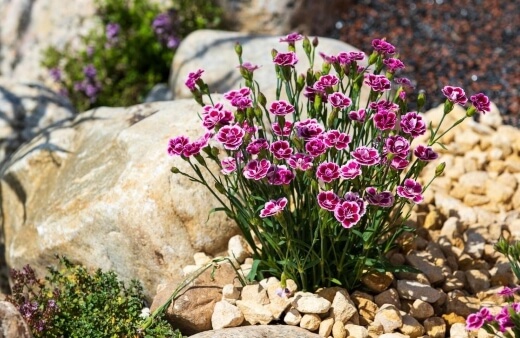
How to Water Dianthus
Dianthus are drought-tolerant plants, but do benefit from water in dry spells or particularly warm summers. There is no point giving them a routine watering every week as this is much more likely to kill them than feed them, so avoid watering dianthus unless the soil is visibly dry.
Dead-heading Dianthus
Dianthus don’t need pruning or cutting back. If there is a risk of frost, it can kill off a lot of top growth, but it will grow back in spring.
Throughout the flowering seasons though, it is important to keep dead-heading dianthus, as it prolongs their flowering seasons and prevents them from putting all their energy into seed production.
If your plants do go to seed though, make the most of it and try sowing them when the seed heads dry out. You’ll have dozens more plants for next year that way.
Repotting
Dianthus spread very slowly so need repotting very rarely. If you need to move them, simply dig the entire plant out with a trowel and place it in a new pot filled with well-drained compost, improved with grit.
If the plant is outgrowing its container, one simple option is to tip the entire plant out of the pot (root-ball and all) and split it right down the middle.
It’s that simple, that’s two plants from one. Really mature dianthus can be split into four new plants if you’re brave.
Light Requirements
Dianthus need full sun, and won’t tolerate shade at all. If you have a South facing garden, consider where the sun falls in the afternoon.
Any spot with more than 6 hours of direct sunlight will be perfect for dianthus plants but the more sunshine you can give dianthus plants, the better.
Common Dianthus Pests and Diseases
Aphids and spider mites are the only common dianthus pests. They don’t attract slugs and snails, and there are no animals that have developed a taste for them so they are really quite safe in the garden.
If you ever notice aphids or spider mites on dianthus, just blast them off with a hose in dry weather or plant flowers that attract ladybirds in the surrounding area.
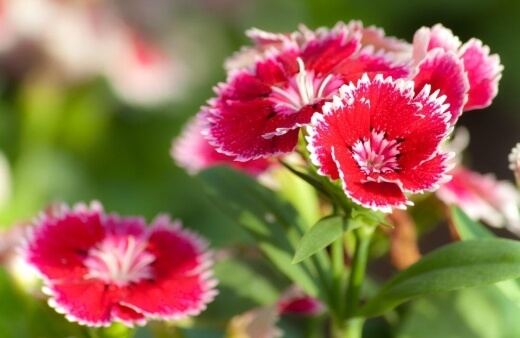
The only diseases that will actually kill dianthus are caused by over-watering and high humidity, so in most parts of Australia, leaving to their own business and letting nature take care of them is enough care.
However, if you do notice brown patches or spots on the leaves these can be the signs of serious problems that need to be dealt with before they take over the plant. Here’s our guide to dealing with the most common dianthus diseases:
Bacterial Leaf Spot on Dianthus
There are a few different causes of bacterial leaf spot, and dianthus leaf spot, but the most common is wet foliage. Tiny scratches and scraps to leaf surfaces aren’t visible to the naked eye but are enough to let bacteria in, so when you water leaves and raise the humidity, bacteria spread by insects takes hold and causes even brown spots across the leaves.
To prevent leaf spots from spreading to other parts of the plant, keep the leaves dry and water only from the base, and remove any spotted leaves so they don’t have the opportunity to spread to other healthy growth.
Dianthus Fusarium Wilt / Stem Rot
Fusarium wilt will lead to all the new growth in spring and summer turning yellow and dropping to the floor. Also called dianthus stem rot, this fungal disease spreads through airborne spores, and grasps onto damp plant material or settles into damp soil.
You’ll quickly begin to see that patches of the plant turn yellow together and the stems become misshapen. There is no way to cure fusarium wilt once it has set in, but you can remove the affected parts of the plant and change the soil to prevent it from spreading.
Using organic fungicides and slightly raising the soil pH can help kill the fungal spores too.
The same symptoms are present in other causes of stem rot, including Rhizoctonia fungus which, again, needs to be cut out of the plant and disposed of, before cleaning the rest of the plant to prevent cross-contamination.
Common Problems & Tips for Planting Pinks
Aside from problems caused by pests and diseases, dianthus can suffer if they are left in damp conditions. If you ever notice yellowing leaves without any other signs of rot (like wonky stems, or black patches), the best solution is to dig them up and move them somewhere brighter.
If you love your dianthus in their current position though and want to help drainage rather than increase light and heat then try digging them up, pouring a layer of horticultural grit into the base of the planting hole, and then pop your plant back into the hole.
Within a few weeks, it should start to respond positively to the improved drainage.
Frequently Asked Questions About Dianthus
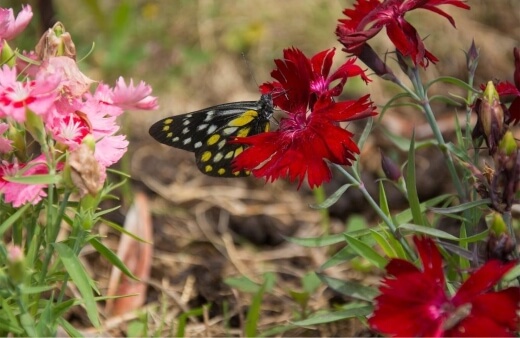
Does dianthus grow back every year?
Dianthus are perennial plants that grow back every year. They are sold as tight clump-forming plants and for the first few years they will work well in formal gardens, but after about four years they will start to look leggy.
You can either cut them back to the ground to sprout or move them to a more naturalised part of the garden.
Does dianthus grow well in pots?
Dianthus are perfect for pots and containers and are much easier to grow for most gardeners when you have control of the soil mixture for container planted dianthus.
They love good drainage, and full sun, so by planting pinks in containers you can perfectly control their soil, light and moisture.
Do dianthus spread?
Dianthus spread very slowly, but will eventually form a carpet of evenly coloured flowers on top of delicate silvery foliage. Because they’re slow to spread, you can easily control them and keep them neatly restricted to just one part of the garden though, and they certainly won’t become uncontrollable.
Will dianthus bloom all summer?
Dianthus are one of the most reliable flowering plants in the garden, blooming all spring, all summer and even into the early autumn once they have fully established.
To get the most out of their flowers, you need to dead-head spent flowers as soon as they start to fade. This lets new flowers shoot up and take their place.
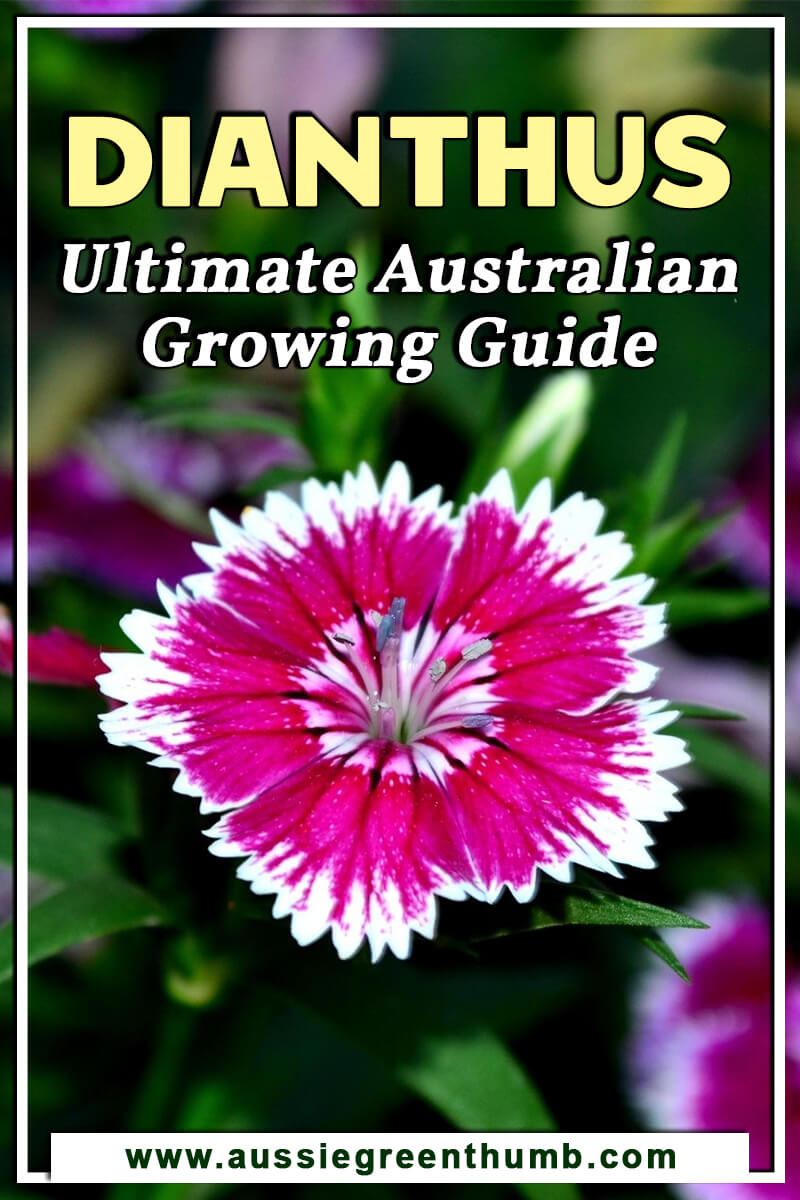
Add a Pop of Color and Fragrance to Your Garden with Dianthus
With so many varieties of dianthus to choose from, there’s no excuse not to grow them, and for just a few dollars this year, you can divide plants, take cuttings and increase your stock to completely fill borders next year, which makes dianthus a great, budget-friendly, garden plant.
I’m obviously biassed, but I do hope we’ve managed to convince you that you’re missing out if you’re not already growing dianthus. If you had any hesitations before reading our ultimate guide to growing dianthus, hopefully now you’re feeling confident enough to try for yourself.
Published on February 1, 2022 by Maisie Blevins
Last Updated on February 12, 2024

